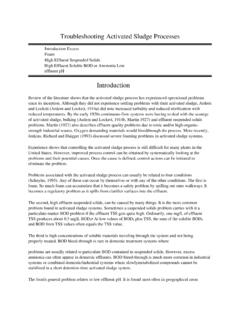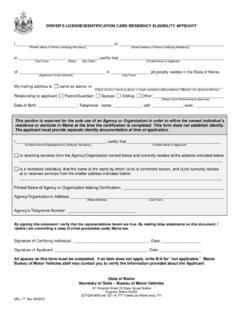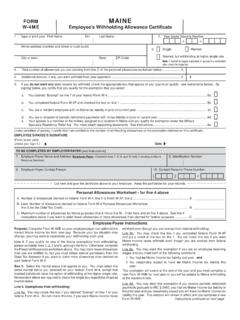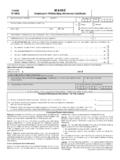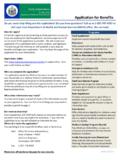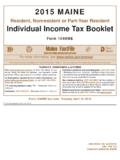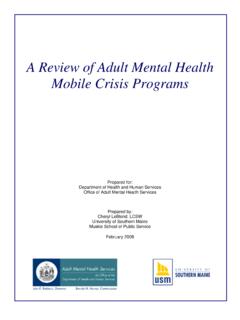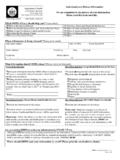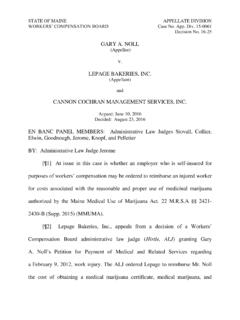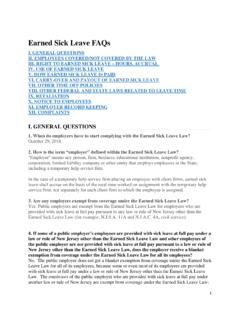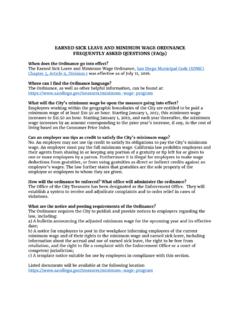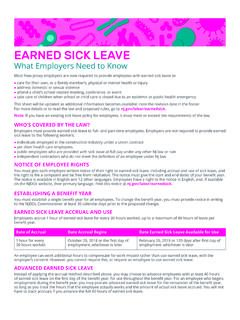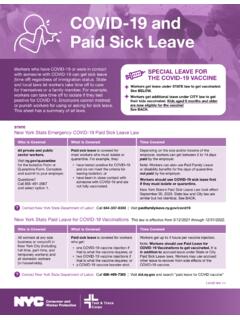Transcription of Frequently Asked Questions and Answers on Earned Paid ...
1 Frequently Asked Questions and Answers on Earned paid leave (LD 369). Maine Department of Labor - Bureau of Labor Standards January 2021. The Maine Department of Labor provides equal opportunity in employment and programs. Auxiliary aids and services are available to individuals with disabilities upon request Page 0. Table of Contents Disclaimer ..2. Introduction ..2. Questions and Answers , by Subject Area ..2. II. Definitions ..2. : Base Rate of Pay ..2. : Covered Employee ..4. II. F: Covered Employer ..8. : Emergency and Sudden Necessity ..9. II. K: Hours Worked 40-hour Presumption for Salaried Workers ..9. : Year of Employment ..9. III. Accrual ..9. : Rate ..9. : Waiting Period .. 10. : Carry-Over of Unused leave .. 11. : Payout of Unused leave .. 11. V: Notice of Use of leave .. 12. : Reasonable Notice Four Weeks' Notice Limit (Written notice, documentation).
2 12. : Scheduling of 12. : One-Hour 13. Other Issues Raised .. 13. Pre-Existing leave 13. EPL and Federal leave Laws .. 15. Retaliation Concern .. 15. Notices/Posters (26 MRS section 42-B) .. 15. Page 1. Disclaimer The Earned paid leave law establishes a minimum standard for paid time off in the State of Maine. Covered employers must meet this minimum standard, but the law does not require an employer to limit or reduce existing paid time off benefits. Many employers may already have a paid time off policy that meets or exceeds the minimum requirements of this law. The following information is general guidance based on hypothetical scenarios. It is not legal advice on any specific situation. Individual cases must be analyzed and decided by the Bureau of Labor Standards (BLS). Introduction These Frequently Asked Questions come from the listening sessions held in the Fall of 2019, public comments received on the proposed Rules, public webinar sessions in 2020, and conversations among Maine Department of Labor staff.
3 The Answers below are intended to clarify the Rules, the law, and the expectations for compliance. Questions and Answers , by Subject Area II. Definitions : Base Rate of Pay . 1. Employer question : How do I calculate the rate I pay employees when they use accrued Earned paid leave ? Answer: The Earned paid leave law states that Earned leave must be paid at least the same base rate of pay that the employee received immediately before taking Earned leave and that employees must receive the same benefits as those provided under established policies of the employer pertaining to other types of paid leave . The Rules define the base rate of pay as follows: The base rate of pay for purposes of Earned paid leave required by this statute is identical to the regular rate of pay defined in section 26 MRS 664(3). The base rate will be calculated by reference to the week immediately prior to the leave taken.
4 The section of the Minimum Wage statute that defines the regular rate of pay applies to non-exempt employees only. Salaried exempt employees are paid a predetermined fixed amount so their base rate of pay is the hourly equivalent of their salary. Page 2. The base rate of pay for nonexempt employees is calculated by dividing the total straight-time earnings for the week, which includes any additional compensation included in the definition of the regular rate, by the total hours worked. 26 MRS 664 (3) establishes that the regular hourly rate includes all earnings, bonuses, commissions, and other compensation that is paid or due based on actual work performed and does not include any sums excluded from the definition of regular rate under the Fair Labor Standards Act, 29 USC, section 207(e). NOTE: Half-time wages associated with overtime pay is excluded from the definition of regular rate and therefore not included in the base rate calculation.
5 Fair Labor Standards Act: 2. Employer question : How do I determine the base rate of pay for a per diem employee like a substitute teacher? Answer: The base rate of pay is determined by looking at the most recent week worked by a per diem employee. The total earnings from that week, divided by the total hours worked will equal the base rate of pay. 3. Employee question : I have more than one rate of pay during the week. How do I know what my base rate of pay is? Answer: The base rate of pay is calculated by dividing the total earnings for the week by the total hours worked. For example: If you worked 15 hours at $ per hour and 25 hours at $ per hour the week before using your Earned paid leave , your base rate will be calculated as follows: 15 hours X $13 = $195. 25 hours X $15 = $375. Total earnings = $570. $570 40 hours = $ per hour base rate of pay.
6 4. Employee question : I work in a restaurant and I have multiple rates of pay, all using the tip credit. Answer: If all rates of pay are based on the tip credit then your base rate of pay is actually minimum wage. Example: Employee works in the following positions during the week. Server at $ per hour plus tips Host at $ per hour plus tips Bartender at $ per hour plus tips As long as your direct wages and tips received when combined at the end of the week total at least minimum wage, then your base rate of pay is minimum wage. Page 3. 5. question : How do I calculate the base rate when an employee receives a nondiscretionary bonus and/or commission? Answer: Bonuses and Commissions are factored into the base rate for non-exempt employees only. However, only the amount associated with the week immediately prior to the employee using Earned paid leave will apply.
7 For example, if the employee is paid on a weekly basis and the bonus or commission is also paid on a weekly basis, then the total amount of the bonus or commission will apply to that week. If the bonus or commission payment is deferred ( , paid on a monthly, quarterly, annual, or other specific timeframes) then the bonus or commission can be prorated to a weekly amount. Example 1: Employee worked 40 hours at $15 per hour = $600. Employee received a weekly bonus of $100. Total earnings for the week are $600 + $100 = $700. $700 40 hours = $ base rate. Example 2: Employee worked 40 hours at $15 per hour = $600. Employee received a monthly bonus of $100. (in this example the bonus applies to a month with 30. days). $100 30 days = $ per day x 7 days in the week = $ bonus applies to one week Total earnings for the week are $600 + $ = $ $ 40 hours = $ base rate.
8 : Covered Employee . 6. question : The Act Authorizing Earned Employee leave ( Earned paid leave Law ) references definitions in the Employment Security Act, which governs unemployment. Does that mean that if an employee is covered by unemployment, the employee is also covered by Earned paid leave ? Answer: As a general rule, yes. The exceptions to employer and employment in the Employment Security Act also apply to coverage for Earned paid leave . Therefore, if you list an employee on your quarterly report to the Bureau of Unemployment Compensation, that employee is covered by Earned paid leave . The only exception is seasonal employees. (See the next question on seasonal employees.). As a general matter, if the employer reports more than 10 employees in its quarterly report to the Maine Department of Labor, Bureau of Unemployment Compensation, then those employees are covered by Earned paid leave .
9 7. Employer question : Can you explain the exception for seasonal employees, including summer interns and international workers (J1, H-2B, etc.)? Answer: The Earned paid leave Law expressly exempts seasonal employees as defined by the Employment Security Act. Page 4. The Unemployment Insurance Commission determines that certain industries are seasonal. A business that operates for fewer than 365 days a year does not necessarily make it seasonal for purposes of this law. Employers that have been determined seasonal by the Department will have two account numbers within the ReEmployME. unemployment insurance system. One account number is for seasonal wages, and the other for non-seasonal. If the employer is within any such industry and the employer has submitted the required report to the Bureau of Unemployment Compensation setting forth the seasonal period for the applicable year, then the employees working only within that seasonal period will be exempt from coverage for Earned paid leave .
10 A list of seasonal industries and their seasonal periods can be found at: Earned paid leave coverage can be determined using the following: 1. Is the business an employer as defined under 26 1043, 9? a. If no Earned paid leave will not apply b. If yes go to question 2. 2. Does the business employ more than 10 employees in Maine for more than 120 days (Total days, not consecutive days) in any calendar year? a. If no Earned paid leave will not apply b. If yes go to question 3. 3. Is the work provided by the worker considered employment as defined under 26 1043, 11? a. If no Earned paid leave will not apply b. If yes go to question 4. 4. Is the employment included in a seasonal industry as defined in 26 1251? a. If no Earned paid leave will apply b. If yes go to question 5. 5. Did the employer (excluding a predefined seasonal business) submit the required report to the Bureau of Unemployment Compensation?
